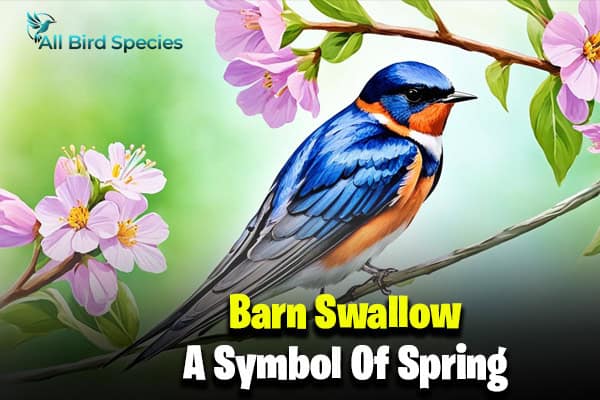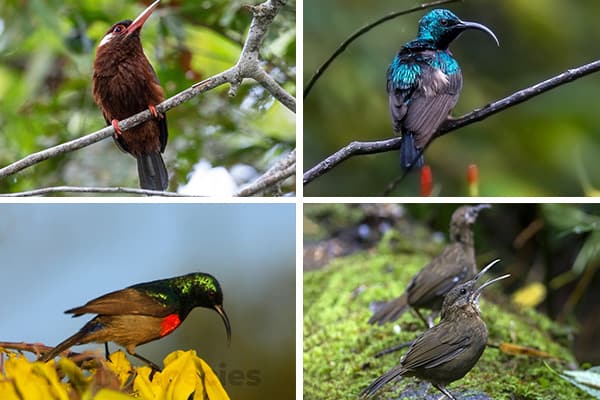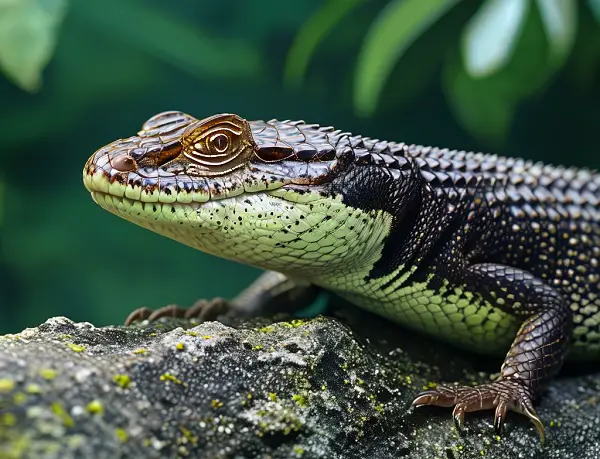Top 7 Most Colorful Birds Around The World (With Pictures)
Most colorful birds grace our world with their vibrant plumage, captivating our eyes and stirring wonder. From the golden pheasant to the swift, iridescent beauty of a hummingbird, these avian wonders never cease to amaze. Let’s embark on a journey to explore these magnificent creatures, complete with breathtaking pictures that showcase their stunning hues. Nature’s artistry awaits!
Learn 7 Most Colorful Birds Around The World
1. Golden Pheasant (Chrysolophus pictus)

The golden pheasant, scientifically known as Chrysolophus pictus, is a magnificent bird celebrated for its vibrant and colorful plumage. This bird’s stunning appearance truly captivates the eye. The male golden pheasant, in particular, boasts a rich combination of colors, including a golden crest, a red face, and long, flowing tail feathers.
The golden pheasant’s striking beak and vibrant plumage make it a true spectacle in the avian world. Its beautiful bird relatives include the scarlet macaw and the northern cardinal. vivid combination of gold, orange, red, and green creates a visual feast for nature enthusiasts and photographers alike.
When it comes to nesting habits, golden pheasants prefer to build their nests in dense vegetation to provide safety and protection for their colorful offspring. Their vibrant colors also serve as a form of camouflage within their natural habitats, similar to the gouldian finch.
The brilliant display of colors exhibited by the golden pheasant is believed to play a role in courtship and attracting a mate. These vibrant hues convey the male’s vitality and health, making them more desirable to potential partners.
Interesting Facts about the Golden Pheasant:
- The golden pheasant is native to the mountainous regions of western China.
- It belongs to the same family as the more commonly known ring-necked pheasant.
- Golden pheasants are known for their ability to fly over long distances with great agility.
- Their vibrant plumage makes them a popular choice for aviaries and zoos around the world.
“The vibrant colors of the golden pheasant’s plumage are truly nature’s masterpiece, showcasing the wonders of evolution.” – Bird Enthusiast
| Feature | Description |
|---|---|
| Scientific Name | Chrysolophus pictus |
| Habitat | Mountainous regions of western China |
| Feathers | Colorful plumage with a vibrant combination of gold, orange, red, and green |
| Beak | Distinguishing feature with a sharp and curved shape |
| Nesting Habits | Builds nests in dense vegetation for protection |
2. Violet Sabrewing (Campylopterus hemileucurus)
In the tropical rainforests of Central and South America, a breathtaking sight awaits those lucky enough to encounter the magnificent violet sabrewing hummingbird. Scientifically known as Campylopterus hemileucurus, this avian wonder captivates with its vibrant plumage and unique features.
The violet sabrewing is renowned for its iridescent feathers, which shimmer and glimmer in a mesmerizing display of colors. The iridescence gives the bird a magical appearance, as if it is adorned with precious gemstones. Its feathers range from shades of deep violet to vibrant green, reflecting different hues depending on the angle of light.
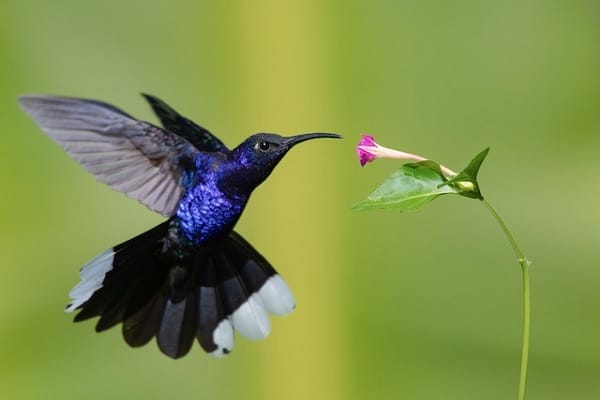
One of the most striking features of the violet sabrewing most colorful birds is its distinctive beak. The long, curved beak is perfectly adapted for reaching nectar deep within the flowers of its rainforest habitat. This specialized beak allows the bird to access valuable nectar hidden within the intricate structures of the blossoms.
Speaking of habitat, the violet sabrewing calls the lush rainforests its home. These vibrant ecosystems provide the perfect backdrop for the bird’s colorful plumage to shine. With an abundance of diverse flora and fauna, the rainforest offers an ideal environment for the violet sabrewing to thrive and display its beauty.
Did You Know?
The violet sabrewing is the largest hummingbird species in Mexico and one of the largest in the world. Its size, coupled with its dazzling colors, makes it an unforgettable sight in the rainforest.
| Common Name | Scientific Name | Size | Habitat | Feeding Habits |
|---|---|---|---|---|
| Violet Sabrewing | Campylopterus hemileucurus | Approximately 5.5 inches (14 cm) | Rainforests of Central and South America | Feeds on flower nectar using its long, curved beak |
Have you ever seen Cockatoos in Australia
3. Fiery-Throated Hummingbird (Panterpe insignis)
The fiery-throated hummingbird, scientifically known as Panterpe insignis, is a true gem among hummingbirds. Its vibrant plumage captivates with fiery shades of red, green, and blue, making it a stunning sight to behold.
These most beautiful birds colorful feathers are not just for show; they also serve important purposes. The fiery-throated hummingbird’s iridescent color helps it attract mates during mating season, as well as camouflage itself from predators in the dense foliage of its highland forest habitat.

One of the remarkable features of the fiery-throated hummingbird is its unique beak structure. The long, slender beak allows it to reach deep into flowers to extract nectar, its main source of energy.
These most colorful birds Found in the highland forests of Central America, including Costa Rica and Panama, the fiery-throated hummingbird has adapted to the cool temperatures and lush vegetation of its mountainous surroundings. These forests provide the perfect environment for these magnificent birds to thrive, with an abundance of nectar-rich flowers and sheltered nesting spots.
Overall, the fiery-throated hummingbird’s stunning colors, specialized beak, and highland forest habitat make it a true marvel of nature.
| Appearance | Behavior of the tanager | Habitat |
|---|---|---|
| The fiery-throated hummingbird has vibrant plumage with fiery shades of red, green, and blue. | This bird is highly territorial and fiercely defends its feeding and nesting areas. | The fiery-throated hummingbird inhabits the highland forests of Central America, home to the toucan and the scarlet macaw. |
| The male has a fiery throat patch that gives it its name. | It feeds primarily on nectar from a variety of flowers. | These forests provide an abundance of nectar-rich flowers and sheltered nesting spots. |
| It has a long, slender beak that allows it to reach deep into flowers to extract nectar. | During mating season, males perform elaborate courtship displays to attract females. | The cool temperatures of the highlands provide a suitable climate for these birds. |
You may want to explore Herons and Egrets in Florida
4. Rainbow Lorikeet (Trichoglossus moluccanus)
The rainbow lorikeet, also known as Trichoglossus moluccanus, is a beautiful parrot species that captivates with its colorful plumage. Native to Australia and Papua New Guinea, a haven for the bird-of-paradise, this bird is a stunning display of nature’s vivid palette. With its vibrant feathers in shades of red, orange, blue, green, and yellow, the rainbow lorikeet is a visual masterpiece.
One of the standout features of the rainbow lorikeet is its unique beak. Adapted for its diet of nectar and pollen, the curved beak allows it to reach deep into flowers and extract the sweet sustenance it needs. This specialized beak also plays a crucial role in the bird’s nesting habits.

When it comes to nesting, the rainbow lorikeet shows great intelligence and adaptability. It constructs its nests in tree hollows, using twigs, leaves, and bark to create a cozy and secure home for its young. These birds are known for their communal nesting habits, often forming large colonies where multiple pairs share the same nesting area.
Australia and Papua New Guinea provide the perfect habitat for the rainbow lorikeet, with their lush forests and abundance of flowering trees. These birds are often seen in parks, gardens, and even urban areas, adding a splash of color to the surroundings.
In addition to their colorful plumage and impressive beak, rainbow lorikeets are also known for their playful and sociable behavior. They are highly active birds, constantly in motion as they engage in acrobatic flights and interact with others in their flock.
The rainbow lorikeet is a true treasure of the avian world, showcasing the beauty and diversity found in nature. Its colorful feathers, unique beak, and fascinating nesting habits make it a beloved species in Australia and Papua New Guinea.
Must Read about Birds With Orange Heads
5. European Bee-eater (Merops apiaster)
The European bee-eater, scientifically known as Merops apiaster, is a migratory bird that showcases a stunning combination of bright and vibrant colors. Its colorful plumage and distinctive beak make it a true spectacle to behold. Here, we will delve into the fascinating nesting habits, preferred habitats, and the intriguing reasons behind its colorful appearance.
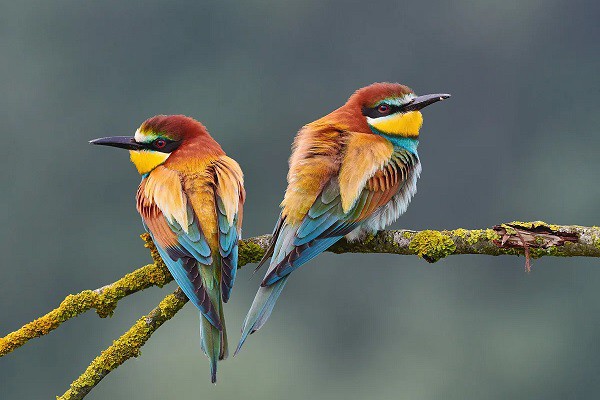
Nesting Habits
The European bee-eater has unique nesting habits that make it stand out among other bird species. They excavate nest burrows in sandy banks, often located near water bodies such as rivers or lakes. The male and female bee-eaters share the responsibility of digging the burrow, creating a cozy and secure space for their eggs and offspring.
Preferred Habitats
These migratory birds can be found in various parts of Europe, including southern and central regions. They are particularly drawn to open habitats such as meadows, farmlands, and grassy plains. These areas provide a plentiful supply of their favorite food source – bees and other flying insects.
Colorful Plumage
The European bee-eater’s colorful plumage is a result of both physical and biological factors. The birds have a combination of green, yellow, and blue feathers, which create a striking contrast against their brown back feathers. This colorful display serves multiple purposes, including attracting potential mates and advertising their hunting prowess to prey.
Did you know? The vibrant colors of the European bee-eater’s plumage are not caused by pigments like most birds. Instead, they are the result of structural coloration. Nanostructures on the feathers interact with light, scattering and reflecting particular wavelengths to create the brilliant hues we see.
In addition to their colorful appearance, these birds possess a slender and curved beak that is perfectly adapted for their diet of bees and other flying insects. The long, sharp beak allows them to snatch their prey in mid-air with impressive precision.
The Migration Journey
The European bee-eater embarks on an extraordinary migration journey, traveling thousands of miles between its breeding and wintering grounds. During the summer months, these birds breed and nest in Europe. However, as the seasons change and food sources diminish, they undertake a long and arduous journey to their wintering grounds in Africa.
Witnessing the European bee-eater in flight, akin to observing the stunning plumage of a bird-of-paradise, is an awe-inspiring sight. Their graceful aerial maneuvers and vibrant colors truly capture the essence of summer.
| Characteristics of the lilac-breasted roller and the scarlet macaw | Details |
|---|---|
| Scientific Name | Merops apiaster |
| Colorful Plumage | Green, yellow, blue |
| Beak Shape | Slender, curved |
| Nesting Habits | Excavates nest burrows in sandy banks |
| Migratory | Yes |
You might be interested to explore Pink Birds in Alabama
6. Indian Peafowl (Pavo cristatus)
The Indian peafowl, scientifically known as Pavo cristatus, is one of the most colorful visually striking birds in the world. With its magnificent display of colorful feathers, including an extravagant crest, this bird captivates the attention of all who see it. The Indian peafowl’s vibrant plumage is a true marvel of nature’s artistry, showcasing vivid hues of blue, green, and gold.
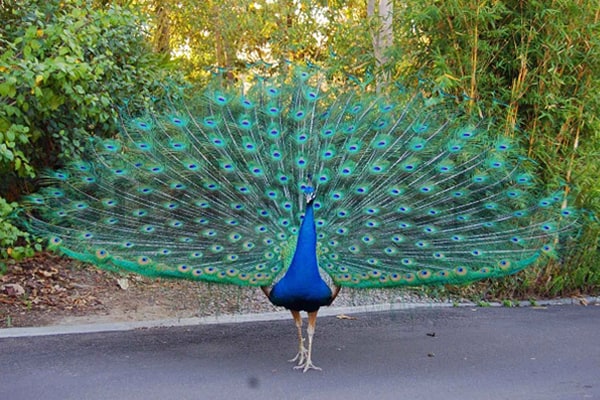
During courtship rituals, the male Indian peafowl puts on a majestic display to attract a mate. With its vibrant train of iridescent feathers fanned out in a stunning fan-shaped arrangement, the peacock performs a mesmerizing dance. The shimmering colors and graceful movements create a captivating spectacle that defines the essence of courtship in the avian world.
The Indian peafowl is native to the Indian subcontinent and is often found in forested areas, open grasslands, and agricultural lands. It is known for its strong adaptability to various habitats, making it a common sight in many parts of the region.
7. Common Kingfisher (Alcedo atthis)
The common kingfisher, scientifically known as Alcedo atthis, is a small but incredibly most colorful birds that can be found near freshwater habitats, ideal for species like the mandarin duck. With its vibrant blue and orange plumage, this bird is a true marvel to behold.

Known for its colorful plumage, the common kingfisher boasts a combination of radiant blue feathers on its wings and back, while its underparts are adorned with a vibrant orange shade. The contrast between these vivid colors creates a visually stunning display.
This exquisite bird is equipped with a sharp, dagger-like beak that is specially designed for its hunting techniques. The common kingfisher dives from perches into the water with incredible speed and precision, using its beak to catch small fish and underwater prey.
These birds, including the painted bunting and the northern cardinal, thrive in freshwater habitats such as rivers, lakes, and streams where they can find an abundant food source. These most colorful birds construct their nests in burrows dug into earthen banks near the water’s edge, providing them with easy access to their hunting grounds.


